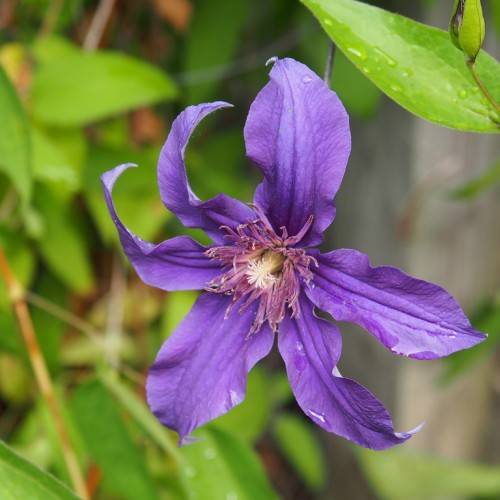
clematis
Clematis 'Cleminov 51' SAPPHIRE INDIGO
Cycle:
Herbaceous Perennial
Watering:
Average
Hardiness Zone:
4 - 9
Flowers:
Flowers
Sun:
Full sun,part shade
Leaf:
Yes
Growth Rate:
High
Maintenance:
Low
Salt Tolerant:
Yes
Care Level:
Medium
watering
Clematis (Clematis 'Cleminov 51' SAPPHIRE INDIGO) needs to be watered when the soil has become dry to the touch. Water deeply and thoroughly at least once a week until the plant is established in the ground (usually 2-4 weeks). During the first few weeks, check the soil every other day to make sure it is not drying out too fast. During the vegetative growth season, (April to September) continue to water the clematis at least once a week. For the remainder of the year, water the plant when conditions are dry. Water in the morning or early afternoon instead of at night for better absorption of water. Avoid getting the leaves wet when watering.
sunlight
Clematis 'Cleminov 51' SAPPHIRE INDIGO is a flowering vine that prefers full sun to partial shade. To ensure the best growth and flowering for this species, it should be placed in a spot that receives 6-8 hours of direct sunlight per day. If possible, avoid planting near trees or tall buildings that might block the sunlight. During the hottest months, the plant may need additional afternoon shade to help prevent burning. It is important to provide adequate airflow between the foliage and the sun, as this will help keep the leaves from drying out and becoming damaged.
pruning
When it comes to pruning clematis of the species Clematis 'Cleminov 51' SAPPHIRE INDIGO, it really depends upon the growth habits of the plant. If the plant is a Category 1 clematis, meaning it blooms on old wood, it should be pruned only lightly each year in early spring, just before new growth begins. A light prune should remove any dead, diseased, or weak stems, as well as any crossed or tangled stems. If the clematis is a Category 2 clematis, meaning it blooms on new wood, it should be pruned more heavily each year in spring, removing the old flower stems and dead wood. This type of clematis should also be pruned back to the lowest pair of healthy buds at least 6-12 inches from the soil line each year in order to encourage new growth and better blooms.
FAQ
Can Clematis plants grow in pots?
Yes, Clematis plants can definitely be grown in pots. When planting a Clematis in a pot make sure to use a larger size pot with drainage holes and fill it with a mix of well-draining potting soil and compost. Ensure to keep the root area cool and the pot in a sunny location while providing regular water and fertilization. Check the plant almost daily to make sure it is not becoming too dry. Clematis can do well in a pot and with the right care and conditions, they will thrive.
Are Clematis plants self-pollinating?
No, clematis plants are not self-pollinating. Clematis plants need pollinators such as bees, butterflies, moths and other insects to transfer pollen from the male anthers to the female stigma of the flower in order to produce viable seed. Pollination must also occur within relatively close proximity of the same species in order to create viable hybrid plants.
Can Clematis plants be grown as a houseplant?
Yes, Clematis plants can be grown as a houseplant. It is best to grow them in a pot with full sun and a soil that is rich in organic material and retains moisture. When potting the plant, place a stake or trellis next to the pot so that the vine can climb when it begins to grow. Be sure to water your Clematis plant regularly to keep it healthy and growing. Additionally, keep an eye out for pests and treat with natural insecticides as necessary.
Could Clematis plants survive in a colder climate?
Yes, Clematis plants can survive in colder climates with proper preparation. If planted in the fall, proper mulching should be done to protect the roots from cold temperatures. If planted in the spring, they should be watered frequently to help them adjust to the cooler temperatures more quickly. If temperatures drop below -20°C ( -4°F), additional measures may need to be taken such as the application of protective wraps and thermal insulation. Additionally, plants in exposed areas should be protected from the wind to prevent excessive dehydration. With the right measures in place, Clematis plants can easily survive in colder climates.
Could Clematis plants be grown in a greenhouse?
Yes, clematis plants can be grown in a greenhouse. Due to their vine-like growth habit and tropical native origins, clematis plants thrive in the moist and warm environment of a greenhouse. Clematis are generally grown from cuttings or from dividing existing plants, and benefit from regular pruning and fertilizing. They will also enjoy the indirect light of a greenhouse and the protection from strong winds and temperatures that the humidity and contained environment provides.
